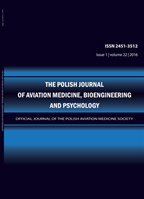2023, Volume 29, Issue 1
COMPARISON OF WEARABLE ACCELEROMETER AND FOREARM-ATTACHED ACTIVITY PATCH FOR MONITORING PHYSICAL ACTIVITY IN BARIATRIC PATIENTS
AGATA P. GAŹDZIŃSKA1, ANNA PRZEWODZKA2, STEFAN P. GAŹDZIŃSKI2
-------------------------------------------------------------------------------------------------
1Department of Psychophysiological Measurements and Human Factor Research, Military Institute of Aviation Medicine
2Creative Neuroscience Lab – CNS Lab, Military Institute of Aviation Medicine
Autor korenspondencyjny: AGATA P. GAŹDZIŃSKA; Department of Psychophysiological Measurements and Human Factor Research, Military Institute of Aviation Medicine; email: agazdzinska@wiml.waw.pl
Full text
Streszczenie
Introduction: Standard, wearable devices for measuring physical activity can be removed by the patient. Therefore, there is concern about the reliability of the results obtained. This study compares selected physical activity measurements obtained with a wearable device to those obtained with an activity patch permanently attached to the patient’s forearm (for the duration of a single week only), providing continuous measurement.
Methods: Physical activity was measured simultaneously with both devices in a group of 14 morbidly obese patients over a period of one week: one month before insertion of intragastric balloon (IGB) and one month after its removal. Selected measures (covered distance and energy expenditure during physical activity) were compared both cross-sectionally and in terms of changes over course of the IGB treatment.
Results: The covered distance measurements obtained using both devices were correlated both before IGB placement and after IGB (r>0.606, p<0.024). Similarly, the increases in distance traveled measurements obtained with both devices were correlated (r=0.76, p=0.04). The obtained measurements of energy expenditure during physical activity correlated only after IGB removal (r=0.600, p=0.012).
Conclusion: The results confirm that in large cohorts, measurements of physical activity obtained with wearable devices are comparable to those obtained with activity patches. However, the possibility remains that in individual cases the measurement may differ due to patient non-compliance.
Słowa kluczowe
physical activity, wearable device, activity patch, obesity, intragastric balloon
